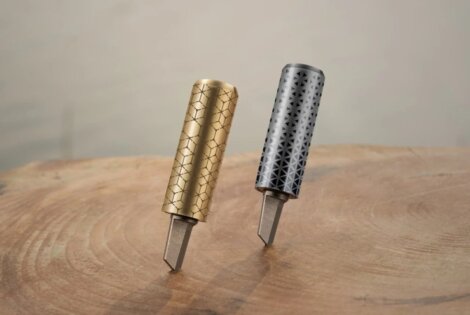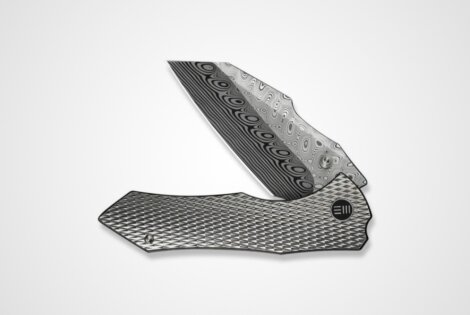Contents
- The Costliest Watches On the Planet
- 1. Patek Philippe Worldtimer Guilloche – $5.5 Million
- 2. Franck Muller Aeternitas Mega 4 – $2.7 Million
- 3. Patek Philippe Platinum World Time – $5.8 Million
- 4. Rolex Daytona Unicorn – $6.1 Million
- 5. Breguet Antique Number 2667 – $4.5 Million
- 6. Hublot Big Bang Diamond – $5 Million
- 7. Patek Philippe Yellow Gold Calibre 89 – $6 Million
- 8. Patek Philippe Titanium Ref. 5208T-010 – $6.6 Million
- 9. Patek Philippe Stainless Steel Ref. 5016 A-010 – $7.9 Million
- 10. Patek Philippe Chronograph Ref. 1527- $6.8 Million
- 11. Vacheron Constantin 57260 – $8 million
- 12. Paul Newman Rolex Daytona – $17.6 Million
- 13. Chopard 201-Carat Watch – $25 Million
- 14. Patek Philippe Stainless Steel Ref. 1518 – $11 million
- 15. Jaeger-LeCoultre Joaillerie 101 Manchette – $26 Million
- What is the most expensive watch in the world?
- How much is the most expensive watch?
- What is the most expensive men’s watch in the world?
- What are the top 10 most expensive watches?
- Luxury Watch Buying Guide & FAQ
If there’s a single word that’s equivalent to luxury watches, it’s costly. The world’s most exciting, extravagant, and exclusive timepieces are multi-million dollar productions, fated to end up in fiercely protected museums if not private compilations.
People refer to it as Haute Horlogerie for a reason.
There are:
- Dress watches
- Pilot watches
- Field watches
- Dive watches
Details on them later.
However, the world’s costliest timepieces are in a category of their own.
Their very raison d’etre seems to be to smash globe records, capture the eye of top gatherers, and motivate Hollywood A-listers, billionaires and millionaires, and members of royal families to empty their pockets.
Coming from the costliest watch labels worldwide, these timepieces capture the fascination of anyone even slightly fascinated in watches with their:
- Precious metals
- Unmatched engineering
- Precious stones
- Exclusivity
- Impressive styling- most being limited editions or one-offs.
Perhaps you’re a watch enthusiast who’d like to own the most expensive watches in the world. But, you don’t know which ones they are.
Not to worry. The post below provides details on this and many more. Read on!
The Progression Of The Wristwatch
The progression of wristwatches is similar to the advancement of timekeeping mechanisms:
Early Timekeeping Instruments
Human beings have been preoccupied with time and keeping tabs on it since the start of time.
- 3500 B.C. Time Stick- the globe’s initial recorded timekeeping gadget and an ancient sundial.
- 1500 B.C. Water Clock- the first time keeping instrument that didn’t need a heavenly body.
- 1200’s A.D. Mechanical Clock- the first timekeeping tool not to utilize water or the sun.
- 1430 A.D. Spring-driven clock- the forerunner of the compact clock.
- 1500’s A.D. Lightweight Clock- the predecessor of the pocket watch.
The 1500’s portable clock manufacture opened the door for the two timekeeping gadgets we’re aware of today.
The Costliest Watches On the Planet
Here are the watches that take the cake when it comes to design, ease of use, and, of course, price:
1. Patek Philippe Worldtimer Guilloche – $5.5 Million
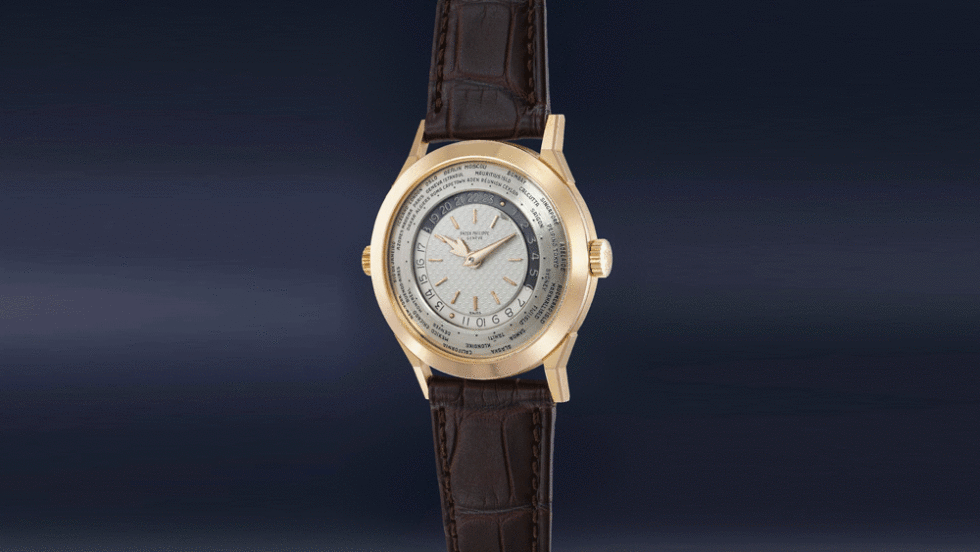
Patek Philippe is a reputable top luxury wristwatch label.
This piece from the brand is among the four currently in existence. Only several versions of this watch have ever appeared at auction.
Its manufacturers design it in beautiful rose gold with a sophisticated and highly distinctive guilloche patterned dial.
Among the initial Patek Philippe makes to include the label’s duplicate-crown structure, you use a single crown to twist the watch and the other to regulate the city disk for the twenty-four-city timer.
The mix of brushed and polished surfaces adds to this masterpiece’s allure.
2. Franck Muller Aeternitas Mega 4 – $2.7 Million
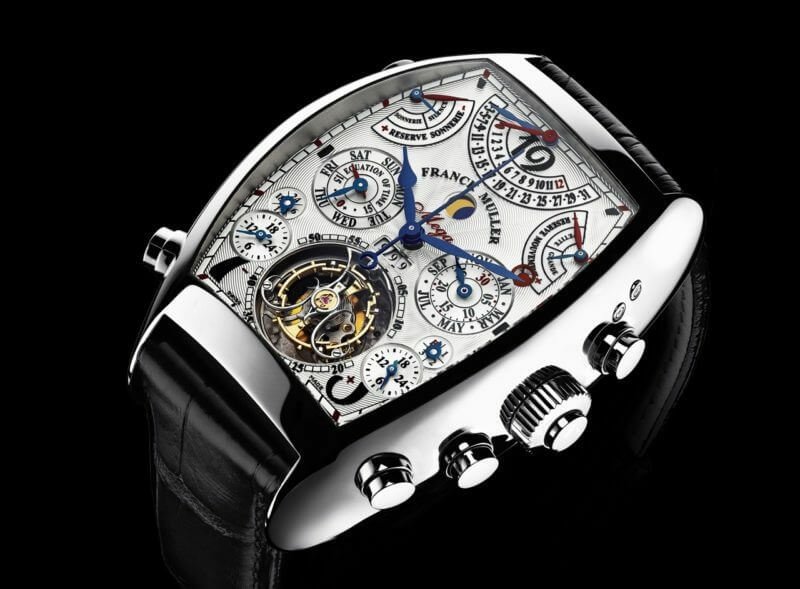
Confusing yet exciting, the Franck Muller Aeternitas Mega 4 has a record for being the most complex timepiece globally.
It features an unbelievable 1483 parts, which is a globe record.
It has a forever-renewable calendar that you don’t have to tune for a thousand years.
3. Patek Philippe Platinum World Time – $5.8 Million
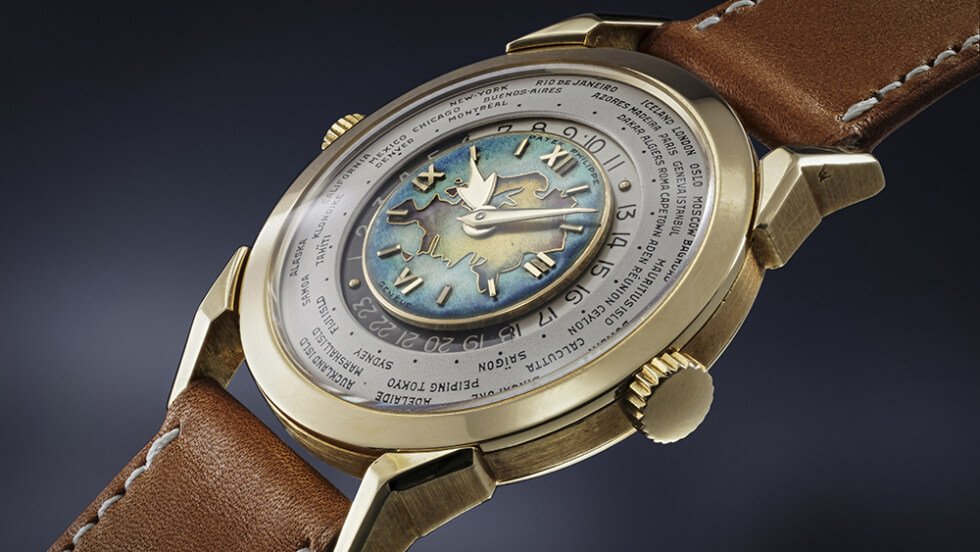
Patek Philippe makes it on the list once more, this time with a watch that broke the world record back in April 2002 as the costliest watch.
It earned this title after going on sale at Antiquorum’s Geneva auction, where an official sold it for six point six million Swiss francs.
Though it’s not the world’s most expensive watch today, it remains a highly desired wristwatch.
The sole platinum backing 1415 HU on the planet, this gift of innovation provides unmatched high-end drama with its monochrome design.
4. Rolex Daytona Unicorn – $6.1 Million
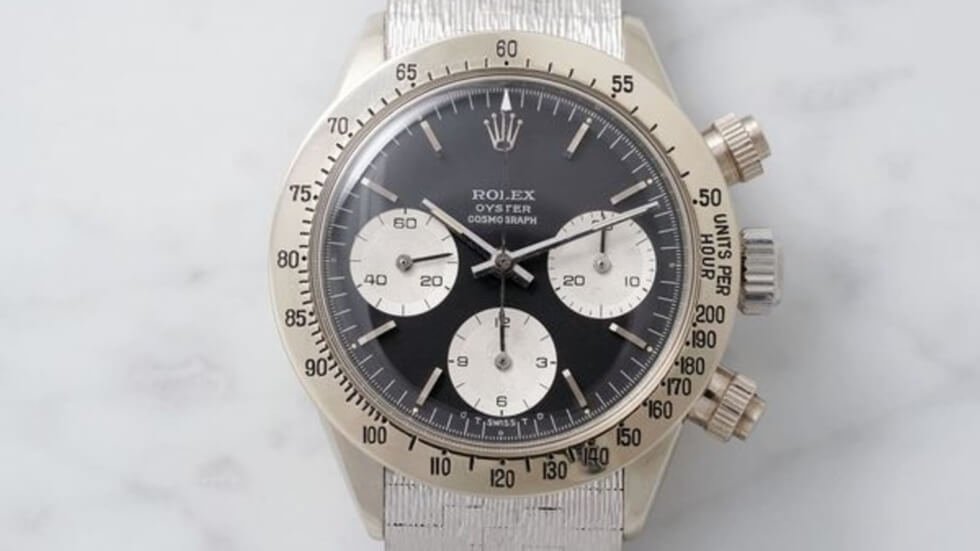
It’s the second-costliest Rolex ever to be sold in public. It has garnered attention since Hodinkee first profiled it back in 2013.
Collectors can’t even imagine the existence of a white gold vintage Daytona.
Producers meant the Daytona to be a daily sports watch. Therefore, the decision to create it from a fabric as opulent as white gold is unorthodox.
It was produced in 1970 and today arrives with a magnificent white gold bracelet. This one-off beauty also has a wonderfully-contrasting black dial with white gold indexes.
5. Breguet Antique Number 2667 – $4.5 Million
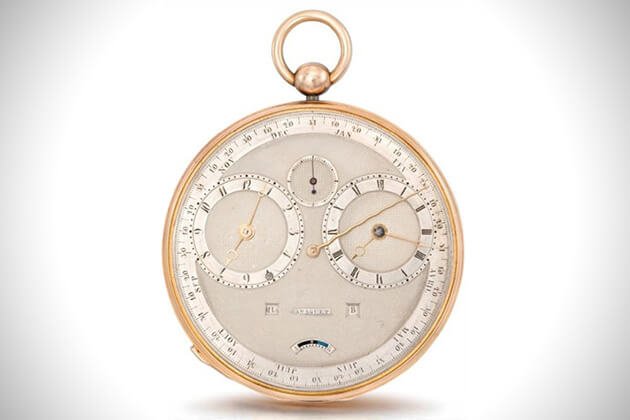
If you’re the type of person who gets an unbearable itchy feeling when you wear a watch around your wrist, then this classic antique pocket watch might be precisely what you need.
Accommodated in eighteen kt yellow gold, the watch comprises several swaying bodies fixed on a sophisticated dial.
Luxurious elegance perfectly pairs with traditional design in this piece.
6. Hublot Big Bang Diamond – $5 Million
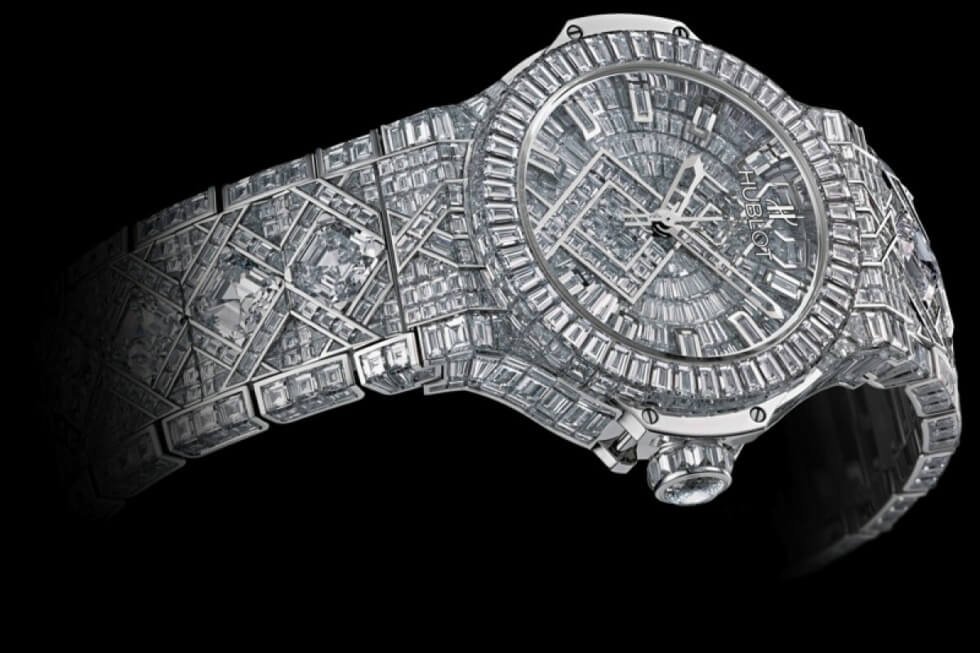
If you crave some bling, then the Hublot Big Bang may be what you seek.
This baby goes for a whopping five million and features 1280 three-carat diamonds, all hand-cut by a New York City Jeweler with forty years’ experience.
On his forty-third birthday, top celeb Jay-Z received it as a present from his wife, the Queen Bee herself.
7. Patek Philippe Yellow Gold Calibre 89 – $6 Million
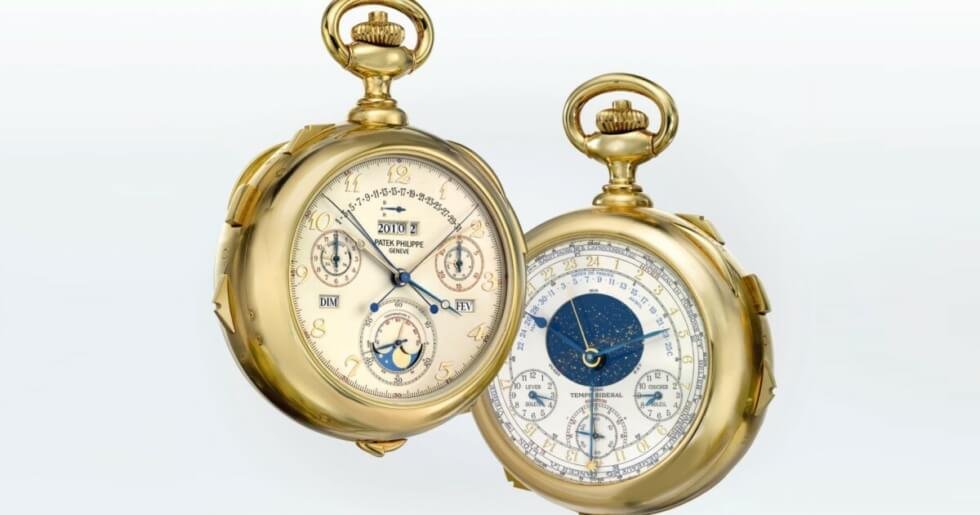
You’ve probably already realized that you’ll be seeing a lot of Patek Philippe on this list. And it’s for a good reason: It makes the best watches!
Known for a while as the most complex timepiece globally, the Calibre 89 by Patek Philippe is one of four alone. Designers make the other three from platinum, pink gold, and white gold.
It weighs a mere one point one kg and features no less than thirty-three complications, comprising:
- Sunset and sunrise times
- A compass
- Split-second chronograph
- Barometer
- Minute repeater
- Altimeter
- A perpetual calendar
- World time for over a hundred cities
It’s no wonder that producers took nine years to construct the movement only- or that it’s a top competitor for the globe’s costliest gold wristwatch.
8. Patek Philippe Titanium Ref. 5208T-010 – $6.6 Million
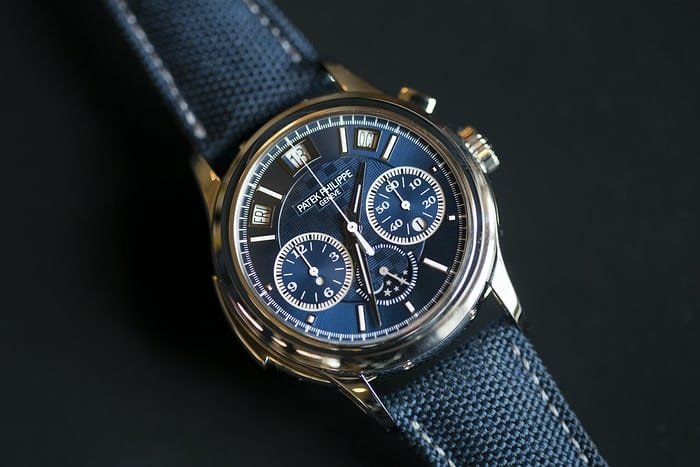
Most of the world’s costliest timepieces are one-offs- or at least incredibly infrequent. A good example is this piece from Patek Philippe.
It’s the first and sole titanium model of the Reference 5208 Triple Complex watch.
The label very rarely utilizes titanium, instantly lifting this wristwatch in collectors’ eyes.
It also has an instantaneous perpetual calendar, a minute replicator, and a monopusher chronograph.
The blue watch countenance has a hand-guilloched ‘Carbon’ decoration, while a display back permits the lucky possessor to appreciate the exemplary artistry at work.
9. Patek Philippe Stainless Steel Ref. 5016 A-010 – $7.9 Million
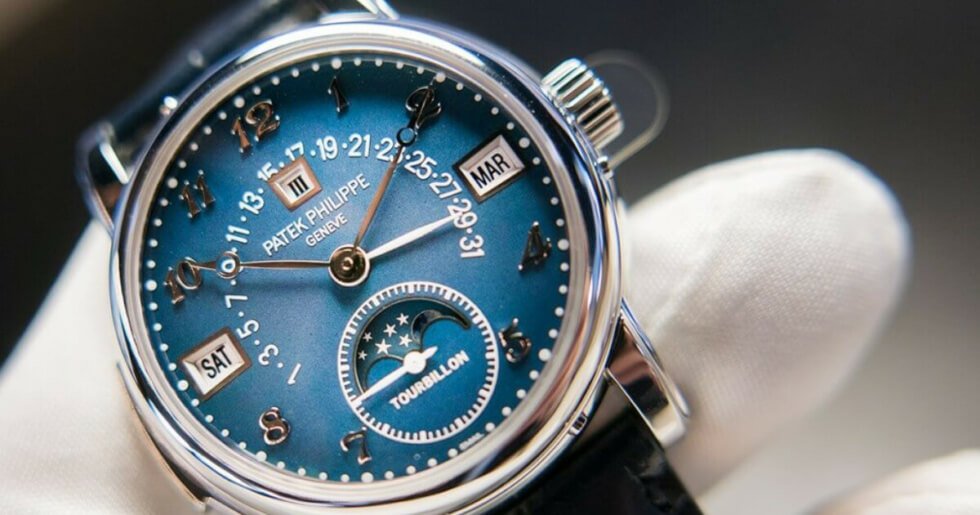
Although Ref.5016 dropped from manufacture around 2011, the organization decided to revive it for this event.
The reference is already incredibly infrequent, and this one-off is completely special, hence the eagerness of watch enthusiasts to dig deep to own it.
It features a continuous calendar with retrograde date, a minute replicator, and a tourbillon- three of the most favorite watch complexes.
It also has a distinctive blue dial crafted from Grand-Feu enamel, and the movement is accommodated in a tiny 36.8 mm case.
10. Patek Philippe Chronograph Ref. 1527- $6.8 Million
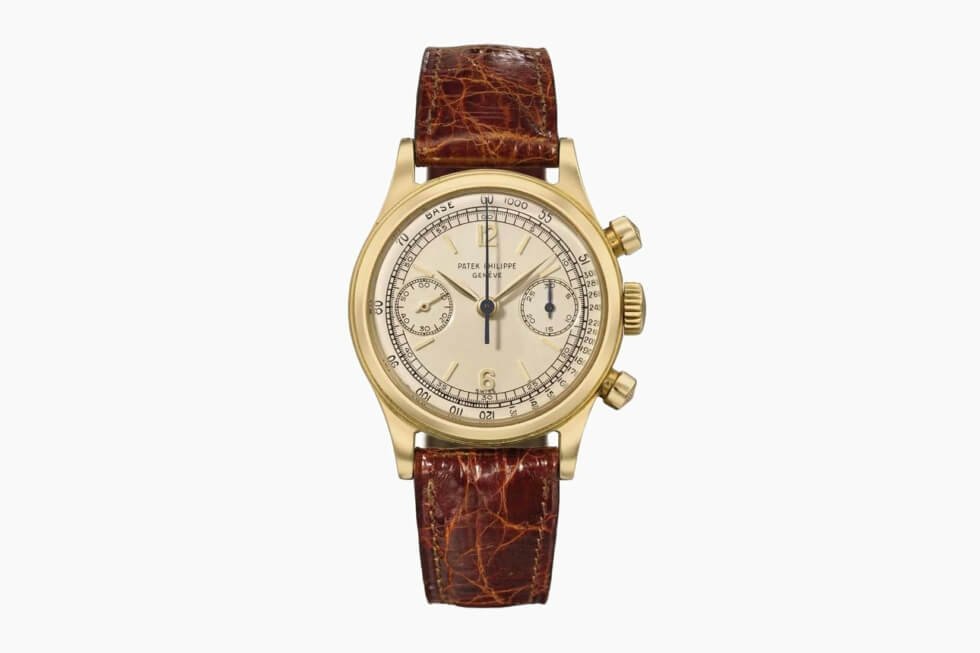
This essential forerunner of future Patek Philippe timepieces caused unrest when its creators released it in the 1940s.
Its case make was unarguably avant-garde in fashion and ratios- bigger, more circular with slightly curved and extended lugs.
Regardless of horology professionals’ efforts to uncover the information, not much is known concerning this timepiece, save that it was only one of the two Ref.1527 wristwatches.
It has a chronograph with moon and date phases. The motion also comprises twenty-three jewels.
Producers made the buckle from 18k gold, plus the watch’s infrequency, partly describes why it fetched such a high cost when sold at auction.
11. Vacheron Constantin 57260 – $8 million
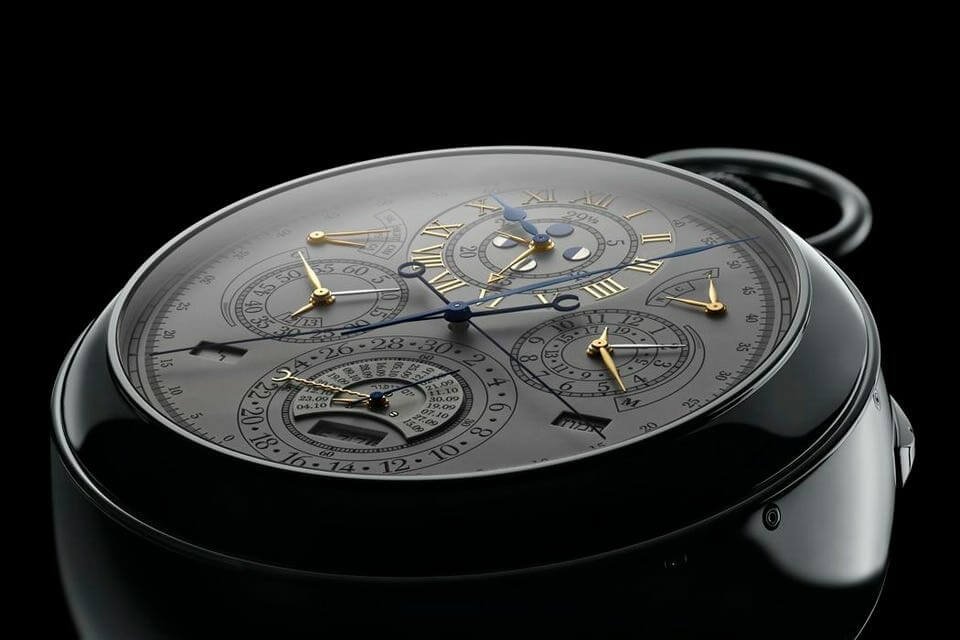
A commission for an individual customer, this piece is the most complex watch on the globe.
It comprises fifty-seven various complications, made up of 242 jewels and 2826 individual parts.
Ten of those complications were brand new horological creations at the moment of production.
Its fantastic functions are a duplicate retrograde split-second chronograph, a Judaic calendar, and a night mode.
The casing is pretty simple, permitting the unrivaled mechanics to take the limelight.
Fun fact: Watchmakers took a whopping eight years to create and design this piece. How about that?
12. Paul Newman Rolex Daytona – $17.6 Million
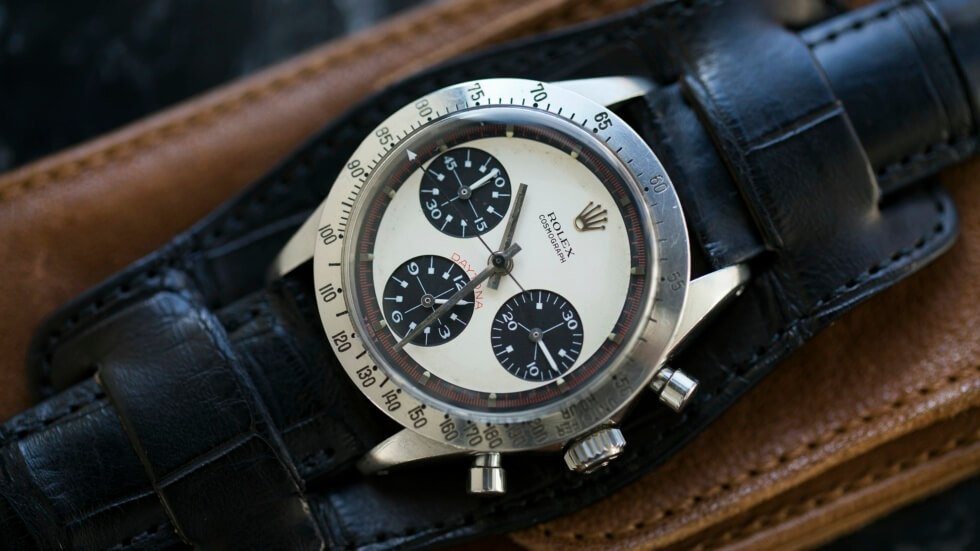
Paul Newman was enthusiastic about horology and knew his stuff in acting. His wife gifted him this timepiece to pay homage to his passions.
The wristwatch has a special cream and black alien dial.
Experts estimate that producers equipped only one in twenty Daytonas with the ‘foreign’ dial because vendors authentically sold them gradually.
However, after the public saw Mr.Newman putting on the watch while going after his racing profession, the cost skyrocketed and was later sold for a bountiful amount at auction.
13. Chopard 201-Carat Watch – $25 Million
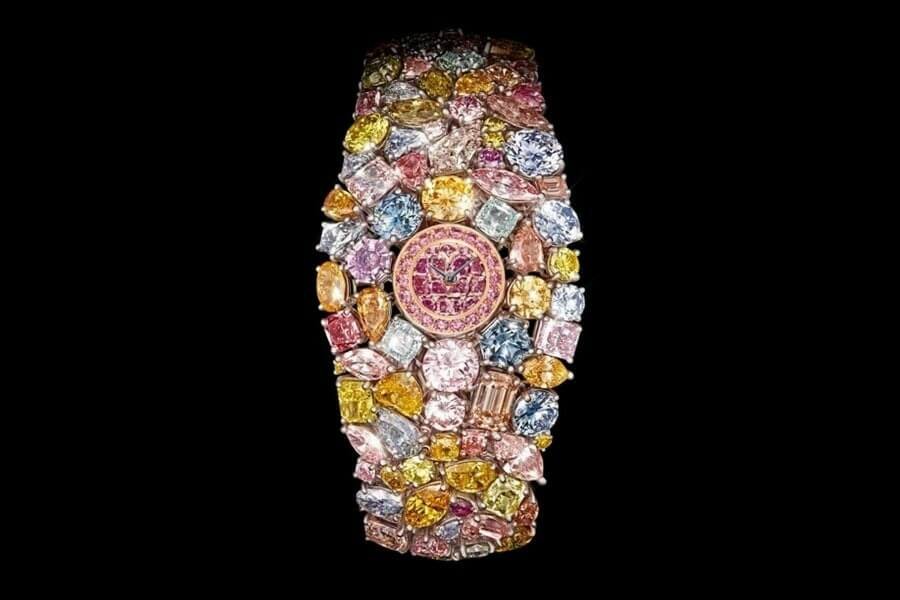
Rejuvenate yourself with the manufacturer’s name to learn why this piece is among the costliest wristwatches.
Its creators coated it with a bunch of colorful diamonds, comprising a fifteen-carat pink diamond, an eleven-carat white diamond, and a twelve-carat blue diamond.
What’s more, there’s an additional 163 carats of yellow and white diamonds that you can notice even from a distance.
14. Patek Philippe Stainless Steel Ref. 1518 – $11 million
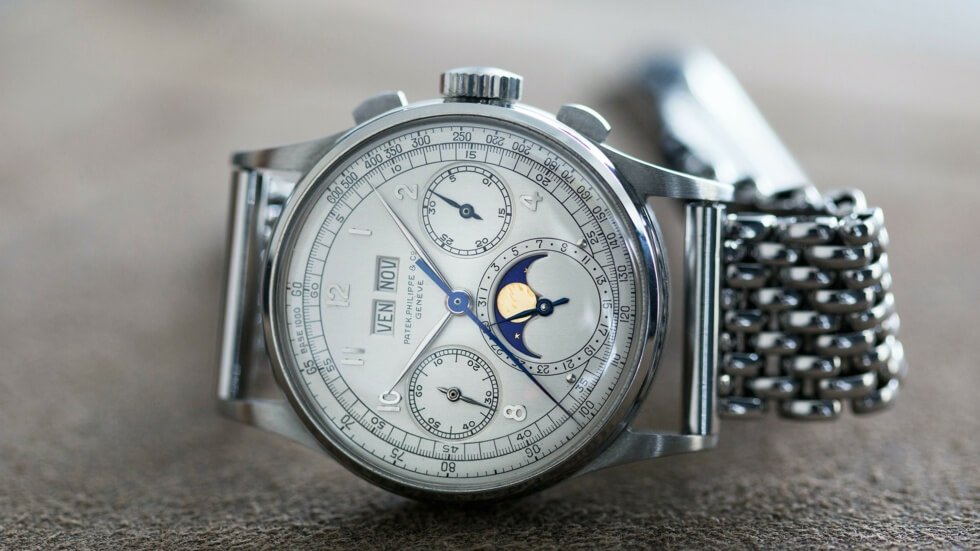
Part of a limited edition four-part sequence, the primary attraction of this specific wristwatch lies in its casing.
Its creators produced it with a high-grade stainless steel case. It differentiates itself from other Patek Philippe luxury timepieces, usually manufactured from rose or yellow gold.
First presented in 1941, this piece made horology news as the initial ever endless chronograph and calendar- yet another reason why this wristwatch is a must-have for watch collectors.
And although you may think steel would make a watch less worthy than gold, it’s challenging to locate high-end watches in this fabric. Infrequency always elevates charges.
15. Jaeger-LeCoultre Joaillerie 101 Manchette – $26 Million
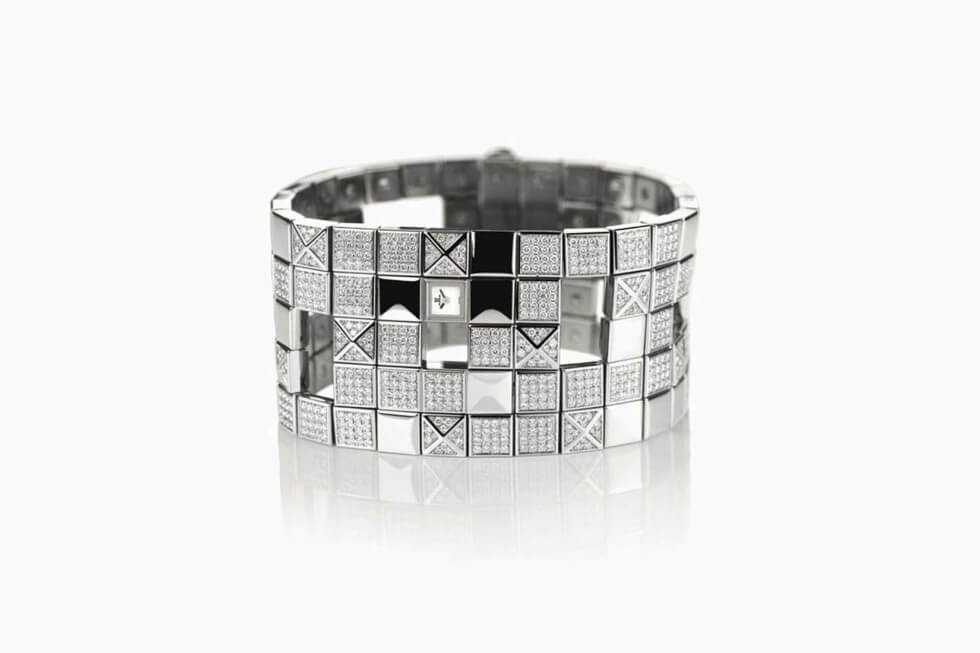
Okay, here’s the thing: Famous label Jaeger LeCoultre made this masterpiece for the one and only Queen Elizabeth II to honor the sixtieth year of her rule. So don’t be surprised that it’s among the top watches.
In truth, with its utterly unmatched profile, crafted from gold and featuring a sequence of well-polished and diamond-set links, and a small caliber 101 motion (among the tiniest on the globe), you deserve to wear it to exclusive state functions and in the halls of historical areas.
One More Thing…
The above timepieces may be costly, but they’re worth every dollar.
Their manufacturers used the best materials on them and made them to perfection for your admiration and contentment.
What is the most expensive watch in the world?
The number 1 most expensive watch in the world is Graff Diamonds: The Hallucination, worth around $55 million. This super-expensive watch boasts 110 carats of different colors of diamonds along with a super small dial.
How much is the most expensive watch?
The most expensive watch ‘The Hallucination’ is reported to be worth $55 million, made by Graff Diamonds.
What is the most expensive men’s watch in the world?
The most expensive watch for men is the Patel Philippe Grandmaster Chime Ref. 6300A-010. With a hammer price of US$31.2 million achieved at the Christie’s Only Watch charity auction back in 2019, in Geneva.
What are the top 10 most expensive watches?
The 10 most expensive watches in the world are as follows:
1. Graff Diamonds: The Hallucination
2. Graff Diamonds: The Fascination
3. Patek Philippe Grandmaster Chime
4. Breguet Grande Complication Marie Antoinette
5. Jaeger-LeCoultre Joaillerie 101 Manchette
6. Chopard 201 carat watch
7. Patek Philippe Henry Graves Supercomplication
8. Rolex Paul Newman Daytona
9. Jacob & Co. Billionaire Watch
10. Patek Philippe Stainless Steel Ref. 1518.
Luxury Watch Buying Guide & FAQ
Wristwatches
As per the Guinness Book of World Records, Swiss watchmaker, Patek Philippe created the first wristwatch in 1868.
They didn’t become popular among adult males until World War I. Before then, most people considered them dainty and feminine…a senseless add-on for adult females.
Individuals started marketing them as a battlefield add-on during WWI. Manufacturers even lived off on the public’s worries.
When soldiers returned home from the War, people thought of the wristwatch as a masculine tool that assisted men in executing war and no longer a womanly accessory.
They stay one of the few add-ons for men that many think are manly.
Pocket Watches
Originally known as ‘pocket clocks,’ pocket watches became accepted during the sixteenth century and stayed the most common watch until World War I.
As their name hints, they were tiny, flat, and crafted to fit in a man’s pocket. They normally had a fixed chain that secured them to a lapel, waistcoat, or belt loop.
Many varieties of pocket watches utilized a manual, mechanical motion.
Types Of Watch Movements
The movement is the watch’s motor.
While its fount of power differs, it’s what moves your watch’s hands, runs any of the watch’s other functions, and keeps tabs on the date.
Generally speaking, there are two various kinds of motions:
Quartz Movement
Seiko presented the quartz motion in 1969.
This exhaustive movement was electronic and made its mechanical forerunner outdated in nearly every way.
Some of its benefits are:
- It needs very little maintenance
- It’s more cost-friendly
- It’s precisely accurate
How It Works
The mainspring is substituted by a cell in quartz motion timepieces.
This battery relays an electrical current via the quartz crystal, electrifying it and leading it to vibrate (over thirty thousand times each second).
These quivers power the engine that drives the timepiece’s hands and other functions.
When a watch says ‘Quartz’ it means that it’s powered by a movement that controls time via the use of a crystal that manufacturers create from the mineral quartz.
Quartz timepieces still have devices to turn the hour, second, and minute hands (except if the wristwatch doesn’t have hands, i.e., digital watches), plus any other complications.
The quartz mineral has the piezoelectric characteristic. This means that introducing any stress to the material’s formation creates an electrical impulse.
The reverse is correct as well, meaning that the material vibrates when you charge it with electricity.
Mechanical (Automatic And Manual) Movement
It uses a looped spring, referred to as a mainspring, that gradually unwinds to expel its power.
The mechanical motion was the device that powered the initial portable watches.
Through springs and gears, this expelled energy is routed to energize the watch’s countless functions, such as keeping track of the date or turning the hands.
Basically, that’s how a mechanical movement functions. You can’t wind a quartz watch since it runs continuously when it has a battery inside it.
There are several unique kinds of mechanical movements:
Manual (Hand-Wind) Motion
The manual movement is the oldest kind of watch motion and was fixed in the first lightweight watch ever created.
As the name proposes, the wearer should coil the mainspring by turning the crown by hand.
You should wind a manual wind watch whenever the mainspring runs out (i.e., the watch ceases to run).
Turning the crown is the only way to wind a manual wind wristwatch. And, the crown will hit a specific stopping place when you’ve fully wound the watch.
You can injure a manual wind watch if you forcibly over-wind it.
Automatic (Self-Wind) Movement
John Harwood included a rotor to the mechanical motion in 1920 and made the first instinctive motion.
You can get that the movement instinctively coils its mainspring from the name.
Here’s how it works: The rotor revolves as the wearer moves their wrist. This revolution builds kinetic power, which the watch uses to turn the mainspring.
Therefore, while the mainspring is continuously loosening (to power the watch), it’s constantly tightening as well (so long as the wearer’s wrist is moving).
While quartz watches made automatic timepieces outdated, you can still find them today in luxury wrist watches such as Cartier, Rolex, Piguet, and Audemars.
Complications Explained
A watch complication is anything that does a task beyond and above keeping time.
The following are some common complications:
Tourbillon
Said as ‘Tour-Be-Yon,’ a tourbillon isn’t a complication per se since its work is to enhance the watch’s timekeeping.
However, it’s the most complex gadget on the globe of horology. It lowers the negative impacts of gravity on a mechanical watch’s timekeeping by putting the balance tire (the most frequently moving piece of a mechanical watch) in multiple places, even while the timepiece isn’t moving.
This averages out the blunder because of gravity and makes the watch more precise over time.
A basic tourbillon goes around on a single axis while triple and duplicate tourbillon complications- which experts often put in the group of grand complications- turn the balance wheel on three and two axes.
Power Reserve Indicator
A power reserve indicator timepiece has a sundial that indicates how much run time or wind remains on the watch.
Some of the highest-end railroad pocket timepieces had an energy reserve indicator that experts usually referred to as an up-down indicator (it was either more twisted down or more twisted up).
Day/Date
This kind of complication shows the month, day of the week, and calendar date.
Simple day/date tools have a standard month extent of thirty-one days that you have to reset every month.
Progressive date complications consider long and brief months and can be precise for a year when running non-stop (referred to as a yearly calendar watch).
Extremely advanced date complications even consider the leap year and show a precise date for countless years (called a never-ending calendar watch).
Repeater
Manufacturers created them for users to hear the time when they can’t see their watch’s face.
When you press the repeater switch, the watch ‘repeats’ the time by use of a chime.
Like a chiming clock, an hour repeater would ring ten times if it’s 10:24 or 10:53, a quarter redoer will ring out the quarter hours plus hours.
A five-minute repeater will ring out the five-minute interludes following the hour, and a minute redoer- the peak of replicators- will ring out the time down to the minute.
Some gadgets even use various chimes to differentiate between hours and tinier interludes.
Chronometer
A chronometer is a highly accurate watch that has passed a suggested set of precision assessments.
Swiss watches must undergo the COSC to receive the chronometer importance.
The COSC is an evaluating establishment that monitors watches for countless days in different temperatures and adaptations.
If a mechanical timepiece doesn’t remain in a range of minus four to plus six seconds of difference each day, then it fails.
Marine chronometers are a particular group of chronometer that arrives in the shape of an extremely precise clock draped in a gyroscopic pack. People regularly used marine chronometers on ships to assist in deciding the location.
Moon Phase
A moon stage wristwatch tracks the lunar pattern using a curved opening (viewing window) and a dial.
The pattern from new moon to waxing moon to complete moon to disappearing moon then back to fresh moon takes roughly 29 and a half days.
A gear with fifty-nine teeth rotated one notch every twelve hours turns the moon dial in a typical moon stage device.
The lunar pattern takes twenty-nine point five three days. Therefore, a standard fifty-nine-tooth device will be off by a single day every two and a half years.
The more progressed a moon stage gadget is, the longer it’ll be right, minus the requirement to change it by hand.
GMT
Professionals got the name from the term Greenwich Mean Time, which scientists made in the 1880s to be the middle of time for the globe.
The GMT watch characteristic permits users to track several time zones at the same time.
Typically, a GMT watch has a second, hour, and minute hand plus a ‘GMT hand’ that finishes an entire pattern in a day instead of the usual half a day.
The GMT hand points to an isolated 24-hour dial, and you can set it to a varying time zone than the usual hands.
The earliest GMT timepieces simply geared the GMT hand to go round at half the pace of the hour hand, and people used a spinning bezel with twenty-four-hour markings on it to set the second time zone.
More contemporary and advanced watches permit for self-sufficient tuning of the GMT and local time.
Chronograph
In its most primary shape, a chronograph is a stopwatch.
A chronograph watch normally has a subdial or hand to document the seconds passed.
Contemporary chronographs have several switches surrounding the crown; a switch to reset the watch and another button to stop and start the chronograph.
More progressed chronographs differ in how the switches activate the chronograph, but the authentic timepieces had a simple control to begin, cease, and reset the tool in that sequence.
Movement Parts
Mechanical watch motions arrive in numerous sizes and forms. However, the primary timekeeping concept has stayed the same for over a hundred years.
Every mechanical wristwatch contains an escapement, gear train, and a mainspring.
The following are the main components of a hand-operated wind watch motion:
- Pallet fork- it’s a tiny trident-shaped part that turns back and forth to link the balance tire to the gear train. It flips an urge jewel on the balance wheel every time the timepiece ticks to maintain the balance rate. The clicking noise you hear is several pallet jewels (jewels with a rectangular form in the fork) mingling with the specially-formed teeth of the escape wheel of the gear train.
- Bridges- they keep the watch’s parts to the primary plate.
- Twisting wheel- this is the device that links the winding parts to the mainspring. It rotates when you turn the watch.
- Jewel settings/jewels- not all watches contain jewels, many timepieces have a varying amount of gems, and treasures arrive in different forms. However, most jewels behave like bearings that the gears revolve around.
Manufacturers nearly always create the jewels from sapphire or ruby, which are attractive materials for use in watch instruments since they don’t wear. Creators use artificially synthesized gemstones since their crystalline formation is perfect always, unlike original jewels that are at times more worthy for their imperfections.
A fully-jeweled hand-driven wind timepiece with zero complications has seventeen jewels ( an impulse jewel, twelve bearings, two pallet jewels, and two balance cap jewels).
- Balance wheel- it’s the part that sways. It has to be well-balanced, as the name proposes, for the wristwatch to keep proper time. The stick that the balance tire spins around is necessarily very fragile, and it can break given sufficient force from a fall or drop,
There’s a very tiny ‘hairspring’ looped around the staff that decides the rate at which the balance sways.
- Gear train- it’s what links the barrel or mainspring (the energy fount) to the escapement (the time-controlling tool). It lowers the mainspring’s energy so that a tiny amount of wind translates to countless hours of run time.
- Balance Cock or Balance Bridge- this is the bridge that contains the bottom-jeweled bearing for the balance tire.
- Regulator- you can find it on the top of the balance bridge. You can tune it to make tiny variations in the watch’s timekeeping. It’s fixed to the hairspring and impacts the timekeeping by extending or shortening the hairspring.
- Mainspring/balance- the barrel has the mainspring that powers the timepiece. The mainspring is twisted around an arbor inside the barrel, linked to the gear you observe on the movement’s bottom.
Various Styles of Watch Bands
The watch strap is the belt that fixes the watch case to your wrist.
There are a handful of various styles of watch straps, from leather to metal.
Please note that you’re never stuck with a single kind of watch belt. It’s simple to transform your watch band with most watches.
By doing that, you can quickly transform your watch’s appearance to pair with various settings and styles.
The four most accepted types of watch straps are:
Metal
Also known as metal bracelets, you can regularly find metal watch bands in several kinds of wristwatches:
- Dive watches- metal stays cozy when soaking wet.
- Luxury watches- luxury watchmakers often utilize costly, fine metals (such as the 18K white gold).
Metal watch straps may be comfortable, but they tend to be bulkier than other watch belt kinds.
Silicone/Rubber
You can find silicone and rubber in dive and sports watches due to their water/sweat opposition and flexibility.
They’re cozy but are extremely informal- and commonly not very luxurious.
Leather
It’s flexible, smooth, and arguably the most comfortable fabric for a watch belt.
It gives your watch an elegant, classic appearance that’s ideal for expert and formal settings (and everywhere in the middle).
Nylon
You can find this strap in two main kinds of wristwatches:
- Highly long-lasting watches.
- Informal and affordable wristwatches.
It’s durable, comfortable, and incredibly durable. Manufacturers made the popular nylon strap types such as the NATO belt for military purposes.
How to Put on a Watch Properly
There technically may not be a suitable manner to wear a watch, but plenty of history and tradition are engraved into watches’ culture. Therefore, you’ll generally see people wearing them in one particular way or the other.
Here are some queries to aid you in finding your ideal wearing style:
1. How Unyielding Should It Be?
From a style point of view, your timepiece:
- Shouldn’t be so unfastened that it’s revolving around your wrist or falling off it.
- Shouldn’t be so tight that your dermis is protruding from around it.
In between those two, it boils down to personal preference. Would you like your wristwatch to be able to slide around slightly or firmly remain in a single place?
The most common choice is that it should slide up and down your wrist slightly.
2. Should My Timepiece Face be Pointing the Ground or the Sky?
While some individuals put on their watch face pointing down, most people wear it pointing up.
Although the direction you pick is once again purely personal preference, here’s a word of warning: If you prefer the watch-facing-down alternative, you’re more probable to scratch its face.
Face up is the more common choice.
3. Which Wrist Should I Wear My Wristwatch On?
People traditionally wear timepieces on the wrist opposite the hand that you put down with.
For example, a right-handed person would put their watch on their left wrist while a lefty would put theirs on their right wrist.
Why’s that the case? Simple: It’s cozier. Your writing hand is continuously gliding across various surfaces.
And your bare wrist glides much more easily and comfortably than your wrist with a wristwatch.
4. Should I Wear My Watch Below or Above My Wrist Bone?
Here’s another case of personal preference.
However, putting it on below your wrist bone is ideal for several reasons:
- It’s cozier- when you wear it below your wrist bone, your watch can glide up and down your wrist. What’s more, it doesn’t feel restricting at all.
- It has more appeal- most people (watch models) wear their watch below their wrist bone.
Watches That Can Put You in the Big League
Okay, you know by now that there are watches, then there are watches. The first one lets you see the time. The second one tells others your level of taste and class.
It informs them that you care about tradition, time well utilized, and craftsmanship.
Manufacturers often create this kind of watch in a quiet area of Switzerland, where as well as precious metals, cogs, and gears, its designers include something inexpressible as well. Something with more value than simply learning what time it is.
And that uniqueness is what makes purchasing a watch such a delicate procedure.
Here are some classic pieces that’ll help you make a statement wherever you go:
The Dress Watch
The most jewelry-like of watches, a dress watch doesn’t get the kind of recognition it deserves.
Think zero embellishments, Roman numbers, and a simple face.
Usually fixed to a leather belt, the suitable dress watch is super lean so that no one can spot it beneath your cuff until you require it.
Additionally, since dress watches don’t perform any particular function aside from telling the time, producers are likely to craft them from precious metal.
The Driving Watch
Watches and motorsports have a very tight working relationship. And similar to diving and flying, there’s a stuntman degree of attraction that translates properly to its use-built wristwatches.
Driving watches should have a chronograph complication- the stopwatch characteristic is very convenient when outdistancing Ferrari 512s- while some, such as the Omega Speedmaster, also boast a ‘tachymeter’ on the bezel, an instrument for estimating pace.
This is a working relationship that’s just as strong off-track as well.
The Diving Watch
Manufacturers crafted it to work seamlessly in the ocean’s depths. It’s no wonder that it suits divers.
However, many of them don’t ever touch water, with countless choosing a dive watch thanks to its punchy bi-directional bezel, rugged make, and luminous hands and dials: All the attributes that make for an attractive wristwatch.
Most diving timepieces owe their craft prompts to the 1958 Rolex Submariner: The first of its type to function at a drop of a hundred meters.
The Minimalist
Minimalist timepieces do precisely what they say on the tin. Therefore, pared-back watches for pared-back appearances.
Which is excellent if you hope to ace the charge-per-wear proportion. But it’s in step as well with broader trends of simplicity that look to sparing designs first set by the Bauhaus movement.
In addition, some of the more modern labels are a touch more pocket-friendly in their modernist look. And that’s always great.
The Pilot’s Watch
When Cartier first made a wristwatch for Alberto Santos Dumont in 1911, aviation timepieces launched and stay in flight to this very day.
That’s due to their excellent balance of classic touches and technicality, with some versions taking signs from watches that are more than a hundred years old. Suitable for the sky, and good for all else as well.




